Ripley Entertainment Inc.'s Blog, page 356
March 15, 2018
Saint Patrick Didn’t Drive The Snakes Out Of Ireland, Climate Change Did
Featured in Ripley's Believe It or Not!

Or Not
In today’s world many misconceptions have been perpetuated—becoming modern day “facts”—when, in reality, myths and hearsay have taken over. Sorry to burst your bubble, but in this weekly column, Ripley’s puts those delusions to the test, turning your world upside down, because you can’t always…Believe It!
Today: Saint Patrick’s Serpents.
No Snakes in Ireland
 Think of Ireland and you can’t help but think of Saint Patrick’s Day. The holiday, honoring Ireland’s own Saint Patrick, celebrates the holy man’s many deeds and accomplishments, notably the introduction of Christianity to the country. The story of Saint Paddy, however, might just be a sham.
Think of Ireland and you can’t help but think of Saint Patrick’s Day. The holiday, honoring Ireland’s own Saint Patrick, celebrates the holy man’s many deeds and accomplishments, notably the introduction of Christianity to the country. The story of Saint Paddy, however, might just be a sham.
Abducted by Pirates
The real identity of Saint Patrick continues to be debated by historians, but they all agree that Saint Patrick wasn’t even born in Ireland. He was born in Britain, a colony of the Christian Roman Empire.
Coming from a family of wealthy clerics, Patrick was kidnapped by Irish pirates as a child and taken to the Emerald Isles to work as a shepherd. Eventually escaping back home, he resolved to return to Ireland to convert them from their Gaelic pagan tradition.
Becoming a Saint
Credited with introducing Christianity to Ireland, there’s much debate over the accuracy of this claim. While historians are certain Saint Patrick was alive in the 5th century, they aren’t certain he was the first missionary to the Emerald Isles. There’s even a theory that Saint Patrick was actually two people who lived through a 100-year span of time spreading Christianity, and that history combined their stories.
Known for his green wardrobe nowadays, it’s likely he really wore blue robes, which would have been more traditional for the time. Green was likely added to make his legend more in line with Irish colors.

The earliest known depiction of St. Patrick (right).
Slithering Snakes
Wandering the countryside of Ireland, you may notice the absence of snakes. While Britain has a handful of native species, Ireland is completely free of the reptiles—a feat credited to Saint Patrick. The legend goes that Patrick was fasting on a hill for 40 days when a colony of snakes began pestering him. Stricken with divine purpose, Saint Patrick gallantly drove the serpents into the sea, ridding Ireland of the creatures forever.
The truth is, the only snakes ever to live in Ireland have been in zoos or kept as pets. Paleontologists have confirmed that snakes haven’t lived in Ireland for at least 10,000 years. Isolated from mainland Europe, the only way the snakes could come over is for an ice age to strike, lowering sea levels and creating a land bridge. Unfortunately, this would also make Ireland far too cold for reptiles to live. If the temperatures drop, then the land bridge disappears, creating a cyclical barrier against serpents.

Glaciation in Europe
But the Druids
While the literal story doesn’t stand up to scrutiny, we could be taking it a little too literally. Snakes have long been used in Judeo-Christian religion as a symbol of sin and temptation. This is as core an allegory as the story of Adam and Eve. The story, instead, is likely a nod to the work Patrick did to convert the “blasphemous” pagans of the time over to Christianity.
Source: Saint Patrick Didn’t Drive The Snakes Out Of Ireland, Climate Change Did
CARTOON 03-15-2018
March 14, 2018
Stephen Hawking, the Genius Who Never Gave Up
Featured in Ripley's Believe It or Not!

Billed as a scientist only rivaled by Albert Einstein in modern times, Stephen Hawking inspired billions in the pursuit of science and discovery. When he was diagnosed with motor neuron disease in 1963, the budding physicist was given just two years to live. Statistically, 90% of people die within a decade of diagnosis. Despite his firm belief in math, he defied the odds and lived another 55 years, dying at age 76.
 An Icon
An IconWhile his paralysis set in slowly, Hawking was forced to find other ways to communicate. While he first started by motioning to cue cards with his eyebrows, his text-to-voice computer system would become something of a trademark starting in 1986. He initially directed his speech using a keypad, but as the disease progressed, he would eventually use just his cheek to give lectures. As technology improved, he was offered an array of voices to choose from, but decided to stick to his original, stating that he identified with it now. Despite his many accolades, he was known to credit his appearances on The Simpsons for making him so well known.
Retaining much of his wit throughout life, friends and colleagues remarked he had a habit of driving his wheelchair recklessly. At Oxford, Hawking was known as a daredevil on the college rowing team, often steering his team on risky courses and damaging several boats.
One humorous experiment he chose to carry out was a party for time travelers. Despite announcing the event publicly and sending out invitations not a single one showed up. To make sure no one cheated, he actually kept the party a secret until after it had taken place. Sitting alone at the party, he decided he now had scientific evidence that time travel was impossible.

Genius
Extolled as a genius today, biographers note he wasn’t very successful academically in high school. By the time he was in Oxford, he claimed he studied for over 1,000 hours. Hawking collaborated with Roger Penrose to develop a theory of singularities, even offering that the universe may have once started as one.
Stricken with paralysis, Hawking had little ability to write down notes or equations for study, meaning most of his calculations were done entirely in his head. Many compare this to Mozart’s ability to compose symphonies in his mind. Hawking himself describes a sensation of interpreting equations as geometry.
Continuing his research on black holes, he would collaborate to develop the four laws of black hole mechanics and even have a form of radiation emitted from black holes named after him. He would later begin exploring quantum mechanics, with much of his findings abbreviated in the short book, A Brief History of Time, which described much of his work in a way anybody could understand. Finishing the book using his voice-to-text system, it has sold over 10 million copies.
Becoming popular for his work as a science writer, Hawking became important to the proliferation of scientific understanding, the future of humanity, and disability awareness. By the time of his death, he earned his spot as one of the all-time great scientists of the cosmos, alongside figures like Einstein, Galileo, Newton, and Copernicus.
CARTOON 03-14-2018
March 13, 2018
Photographing the Dead and Grieving with Spirit Photography
Featured in Ripley's Believe It or Not!

With mortality rates for children under five sitting above 40% in the mid-1800s, death was commonplace but no less heartbreaking.
As America blazed the Oregon Trail and prepared for an avalanche of death in a brewing Civil War, the bleeding edge technology of the camera was making its way into the most sentimental parts of people’s lives.
While paintings were only affordable for the wealthy, photographs emerged as a way to remember loved ones after they passed. Lost children became particularly popular subjects of these post-mortem photos.

Deceased children were sometimes posed with parents, alone, or with siblings. In a time before photos of everyday life were affordable or common, these photos often served as the only reminder of what someone looked like. While many might be photographed with their eyes closed to look as though they were sleeping, some photographers would fix the eyes open, pose them in action, or even paint the pupils in later.
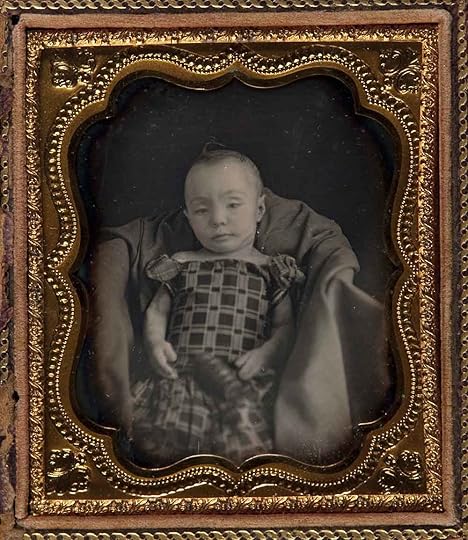
Haunting Hucksters
While early cameras were rudimentary by today’s standards, they were mysteries of science to most people, which unfortunately led to an industry taking advantage of grieving families.
Photographer William Mumler paired up with his medium wife to sell photos of deceased family member’s spirits throughout the 1860s. Likely using a combination of double exposure and painting, he would insert the “ghost” of people’s children, wives, or husbands into the photos.

People had little reference for judging what a real photograph should look like, making them easy prey for this new technique.
Lincoln’s Ghost
One famous example of Mumler’s spirit photography is a photo commissioned by Mary Todd Lincoln. Initially pursuing mediums and spiritualism after the death of her son Willie Lincoln, Mary Todd sought contact with the spirit of her dead husband.

The photo Mumler took shows Abraham Lincoln standing behind his wife. A prime example of the people desperate for spirit photography, the president’s wife was bereft and wealthy.
Source: Photographing the Dead and Grieving with Spirit Photography
A Closer Look At Lily Slippers: Achieving A Three Inch Foot
Featured in Ripley's Believe It or Not!

Unlocking our Cabinet of Curiosities, “Ripley’s Rarities” takes you up close and personal with some of the most interesting exhibits collected by Ripley’s Believe it or Not! since the days of Robert Ripley himself.
Today : Lily Slippers
Foot Binding
The first recorded foot binding, cradled by lily slippers, occurred in 10th century China.
According to lore, Emperor Li Yu built a gilded stage in the shape of a lotus flower for his favorite concubine to dance upon. Dancing on her toes, her feet were bound in a hoof-like shape and adorned with precious stones and ribbons. As this young woman was the emperor’s favorite, women attempted to imitate her to gain his favor, making the practice fashionable.
From the royal court, foot binding spread throughout China, beginning in the South of the country and soon reaching the North.
In the 12th century, the practice had become much more widespread, and by the mid-17th century, every girl who wished to marry—marry wealthy—had her feet bound. The most desirable of brides would possess a 3-inch foot.
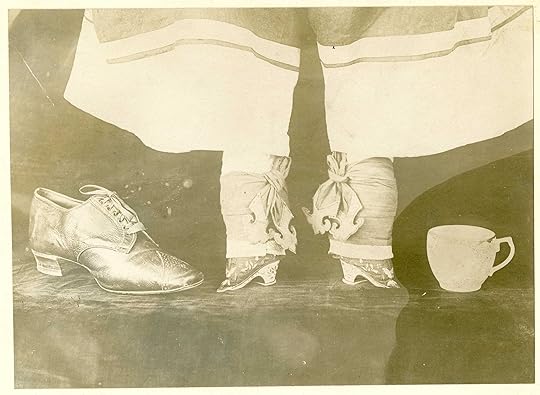
A Painful Process
The foot binding process began as early as age three and was typically carried out by an elder female—not the girl’s mother, as she would be too sympathetic to her child’s pain.
First, the feet would be plunged into either hot water or a mixture of animal blood and herbs, followed by clipping the toenails very short.
The toes would then be broken, pressed down flat against the sole, and secured with silk wrappings. With the weight of walking, the bones would break and the arch of the foot would rise, allowing the heel to almost touch the metatarsals, folding nearly in half like a crescent moon.
Over time, the wrappings became tighter and the shoes smaller, as the heel and sole were slowly crushed together. Throughout this process, which took two years to complete, girls were encouraged to walk long distances to hasten the breaking of their arches.
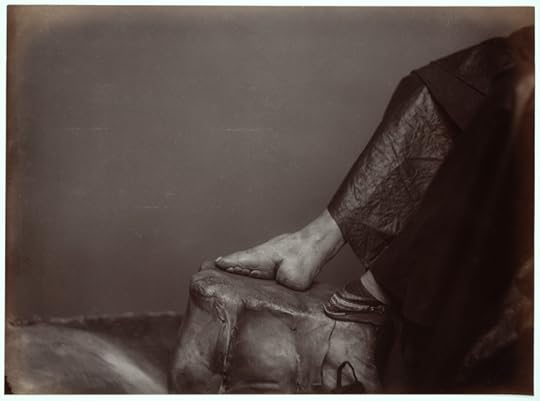
The Heel End
Whether it was their tottering gait or the notion that these women never had to lift a finger, bound feet became so alluring and attractive that they were nearly required in order to find a suitable husband. Due to this, successive generations of Chinese women endured the painful practice for nearly ten centuries.
Pressured to stop in 1874 for obvious reasons, the practice of foot binding was not outlawed until 1901. It wasn’t until Mao’s revolution in 1949 that this torturous tradition came to a complete end.

Source: A Closer Look At Lily Slippers: Achieving A Three Inch Foot
CARTOON 03-13-2018
March 12, 2018
Why Do the Numbers on a Roulette Wheel Add Up To 666?
Featured in Ripley's Believe It or Not!
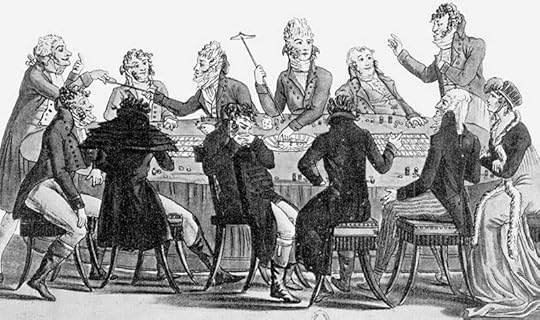
Perhaps one day, while gambling away your children’s inheritance in some nameless casino someone told you that Roulette was invented by Blaise Pascal, a French mathematician and Catholic theologian who lived in the 16th century. Maybe you heard he devised the wheel while trying to create a perpetual motion machine. That part of history may be all well and good, but there’s perhaps a darker side of Roulette’s beginnings that’s not talked about much in “proper” circles. A history that doesn’t begin anywhere near Paris or the 16th century, for that matter. A history that might involve (cue dramatic music)…the Devil?!?!
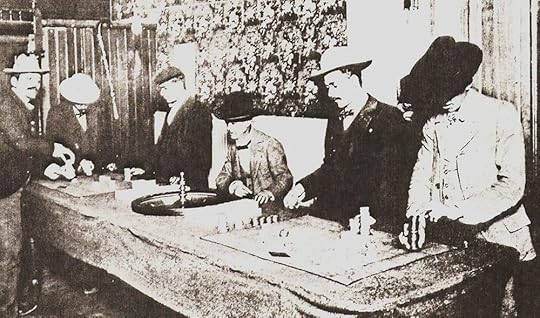
Odds Are…
It’s true. Some historians contend that the origins of Roulette pre-date Pascal’s “little wheel” by at least 200 years. One explanation states that the Chinese had a spinning stone wheel game-of-chance that used drawings of animals instead of numbers. Some versions even go so far as to say the specific monk who developed the game went mad trying to find a way to cheat the game and mysteriously included a “666” inscription at the center of the wheel.
The game could possibly have been traded across the continent for Europe, but others say the Romans were partially responsible. There are some accounts of Legion soldiers gambling by spinning their shields and chariot wheels during off-time.
No matter who invented the game, its association with the devil wasn’t widespread until Francois “Magician of Homburg” Blanc brought Roulette into the spotlight, first in Homburg, but eventually also at the Monte Carlo Casino in Monaco. Built as a temple to wagers, the casino was inundated with gamblers once Germany outlawed gambling. Here, the state government of the micronation ran the casino itself, and Blanc was right at the center.
Rumor was that Blanc had made a deal with the devil to learn the secrets of Roulette, explaining why the numbers added to 666. While gambling halls in Paris at the time had both a zero and double zero for the house, Blanc advertised patrons had better odds of winning because his wheels only featured a single zero.

A double zero layout.
Devil’s in the Details Math
From there, it gets a more complex and—at times—a little arbitrary. For instance, adding any three numbers that appear horizontally together on the Roulette table can be related to the number six. The numbers 28, 29, and 30 appear horizontally toward the end of the table. The total for those three particular numbers added together is 87. Add those digits together (8+7) and you get 15, and if you add the digits once more (1+5) you get the dreaded six!
Another reference to the number 6? Adding any 3 numbers that appear diagonally on the table will combine to get the number six in much the same way. Looking back at the table 12, 14 and 16 appear diagonally. 12+14+16 = 42. Add the 4 and the 2 of 42 together and you’ll never guess what number you’ll get!

34+35+36=105, 1+0+5=6!
While the true person behind these machinations could be a monk, a Roman soldier, or a gambling magnate, it’s likely the mathematician in the mix could be responsible for making a math joke about gambling as a vice.
Still…trying to figure out ways to add the numbers on the Roulette table so they don’t equal six just might make you mad, too.
By Jesse Gormley, contributor for Ripleys.com.
Source: Why Do the Numbers on a Roulette Wheel Add Up To 666?
Curious Creatures Crawl on over to Ripley’s Aquarium of Canada!
Featured in Ripley's Believe It or Not!

One of the most curious creatures to call Ripley’s Aquarium of Canada home is the beautiful, yet ruthless, mantis shrimp.
Believe it or not, the mantis shrimp is not really a shrimp. Otherwise known as stomatopoda, these marine crustaceans are distant cousins of the crab and lobster. Unlike their spiny relatives, the mantis shrimp can punch with the speed of a .22 caliber bullet! That’s strong enough to break aquarium glass, making them a rare sight and treat to see at Ripley’s.
Their eyesight is unparalleled, too. Did you know they have a total of 12 photoreceptors in each eye? It allows the mantis shrimp to see the world like one psychedelic spectrum! As for us, we only really see red, blue, and green.

Older than dinosaurs, scientists have dubbed this creature the shrimp from Mars! They began emerging around 400 million years ago, which means they were sashaying through our waters long before humans and way before dinos stomped the Earth.
Mon Lei
Robert “Believe It or Not!” Ripley was a curious creature himself. During the winter of 1946, Ripley took his Chinese Junk, the Mon Lei, from Mamaroneck, New York, to Tampa, Florida, considering it his three-month-long snowbird vacation.

Ripley had his beloved Mon Lei refurbished with a new engine and an improved look for the journey. Since Chinese belief says the spirits of dragons propel boats, Ripley had the vessel painted with eyes, teeth, and whiskers. He removed the lifting rudder and tiller, replacing them with a wheelhouse. To scare away evil spirits, Ripley placed a yin and yang flag upon the ship.

“He made several stops before getting to Florida, but then parked it in Miami,” said Edward Meyer, VP Exhibits & Archives. “He was in Key West between Christmas and New Years with the boat docked at Mallory Square. He made several public appearances in town, and recorded a radio show from the ship parked at Mallory.”
Ripley traveled deep into the Everglades to film Seminole Indians on the Mon Lei and even held weddings on it for some of his closest friends.
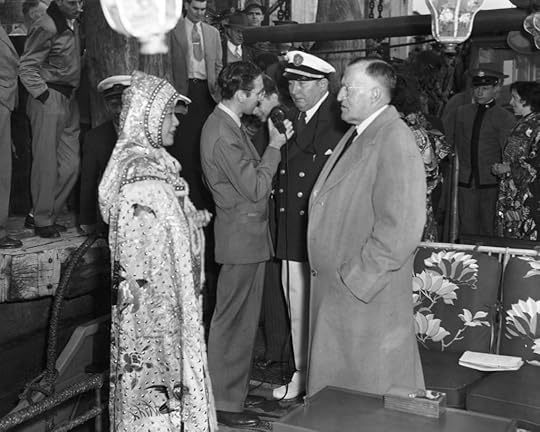
Join Us
Now, it’s your turn to step back in time and sail through the life of Robert Ripley (1890-1949), the iconic “Believe It or Not!” cartoonist, explorer, reporter, adventurer, and collector who traveled to 201 countries in 35 years seeking the odd, the unusual, and the unexplained.
Get ready to explore our NEW Curious Creatures exhibit. From the most remote corners of our blue planet, you will journey from coast to coast and encounter extraordinary sea life, stories, and artifacts along the way. From giant isopods and peacock mantis shrimp, to curious objects of intrigue, immerse yourself in the strange and brilliant life of Robert Ripley.
Visit Our Curious Creatures
To learn more about the Mon Lei, make sure to check out our Weird Minute podcast, and don’t forget you can have a close encounter with a shrimp from Mars at our exclusive Curious Creatures exhibit at Ripley’s Aquarium of Canada now!

Source: Curious Creatures Crawl on over to Ripley’s Aquarium of Canada!
CARTOON 03-12-2018
Ripley Entertainment Inc.'s Blog
- Ripley Entertainment Inc.'s profile
- 52 followers







